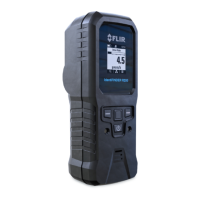The closer these lines are set to the mean value (at say, 1.0 σ), the more likely the system will
alarm as radiation levels fluctuate over time.
The farther away from this average line (for example, 9.9), the more the radiation levels will have
to increase over a given time frame to cover this expanded territory and cross over these
thresholds and thus trip the alarm.
The default (factory) setting for this is 4.0.
A pellet and a photon
So, to recap, the classic example of a "spread" of data captured as a single moment in time is the shotgun
blast pattern on a large, paper target.
Each hole left on the paper by the pellets represents a data point. Were a number (based, say, on
distance from center, or origin) to be assigned to each, a quantity of holes obtained, and an aver-
age calculated (sum of all numbers divided by total number of pellet hole/data point), a line rep-
resenting the average would be drawn through this field of pellet holes and would represent an
average of all.
The paper is what captures the trajectory of the moving pellets. The FLIR identiFINDER R200 is
akin to the paper in that it "captures" nuclide signatures (photons) that are flung from the source of
radiation (the radioactive "shotgun" - blasting in every direction away from the source (the "barrel"
of the shotgun).
In principle, the closer one moves to this mean, the more dense the pellet holes/data points, and
conversely (and in principle) the farther one moves from this average line, the more disperse are
the data points.
Varying the size of the shotgun, the amount of gunpowder and the number of pellets can affect
how the pattern is presented in its spread across the paper target.
The amount of gunpowder in the shell is similar to the radiation "strength"of a source. A smaller
quantity of charge in the shell would cause the pellets to be more dispersed, and a greater
charge would focus the pellets closer to the line representing the average. If this were a source of
radiation, the closer the detector would have to be to this source in order to trip alarms set at cer-
tain deviation set points.
5 - 71 R200 3/10/2017__1:38 PM

